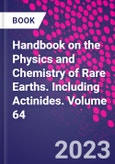Handbook on the Physics and Chemistry of Rare Earths: Including Actinides, Volume 64, the latest release in this continuous series that covers all aspects of rare earth science, including chemistry, life sciences, materials science and physics, presents interesting chapters on a variety of topics, with this release including sections on Structure and properties of Ln2M3Ge5 compounds, Giant magnetocaloric effect materials, Lanthanide-based single-molecule magnets, and Magnetic Refrigeration with Lanthanide-Based Materials.
Please Note: This is an On Demand product, delivery may take up to 11 working days after payment has been received.
Table of Contents
1. Structure and properties of Ln2M3Ge5 compounds
Julia Chan
2. Giant magnetocaloric effect materials
Jia Yan Law
3. Lanthanide-based single-molecule magnets
Joulia Larionova
4. Magnetic Refrigeration with Lanthanide-Based Materials
Michael Shatruk
Authors
Vitalij K. Pecharsky Ames Laboratory, Iowa State University, Ames, IA, USA. V.K. Pecharsky received a combined BSc/MSc degree in Chemistry (1976) and a PhD degree in Inorganic Chemistry (1979) from Lviv State University (now Ivan Franko National University of Lviv) in Ukraine. He held a faculty appointment at the Department of Inorganic Chemistry at Lviv State University between 1979 and 1993, after which he moved to Ames, Iowa, where he became a staff member at the U.S. Department of Energy Ames Laboratory. In 1998 he accepted a faculty position at the Department of Materials Science and Engineering at Iowa State University, while remaining associated with Ames Laboratory. He was named an Anson Marston Distinguished Professor of Engineering in 2006. He also serves as a Faculty Scientists, Field Work Project Leader, and Group Leader at Ames Laboratory.While in Lviv, V. Pecharsky was studying phase relationships and crystallography of ternary intermetallic compounds containing rare earths. After moving to Ames his research interests shifted to examining composition-structure-physical property relationship of rare-earth intermetallic compounds. Together with Karl Gschneidner, Jr., he discovered a new class of materials that exhibit the giant magnetocaloric effect in 1997, triggering worldwide interest in caloric materials and caloric cooling, which promises to become an energy-efficient, environmentally-friendly alternative to conventional vapor-compression approach. Today his research interest include synthesis, structure, experimental thermodynamics, physical and chemical properties of intermetallic compounds containing rare-earth metals; anomalous behavior of 4f-electron systems; magnetostructural phase transformations; physical properties of ultra-pure rare earth metals; caloric materials and systems; hydrogen storage materials; mechanochemistry, mechanically induced solid-state reactions and mechanochemical transformations.
He organized the 28th Rare Earth Research Conference in Ames, Iowa in 2017. He serves as co-editor of the Handbook on the Physics and Chemistry of Rare Earths and senior editor of the Journal of Alloys and Compounds. He has published over 500 WOS papers (>22 600 cites, h factor = 60). Jean-Claude G. Bunzli Swiss Federal Institute of Technology Lausanne (EPFL), Switzerland. J.-C. B�nzli was educated as a physico-chemical inorganic chemist (BSc and PhD at EPFL; postdocs at UBC, Canada and ETH Z�rich). He started to work on lanthanide coordination chemistry in 1975 at the University of Lausanne and was promoted full professor in 1980. In 2001 he transferred to EPFL where he founded the Laboratory of Lanthanide Supramolecular Chemistry.
After studying the solvation of lanthanide ions by innovative experimental techniques, he turned to macrocyclic and supramolecular chemistry, focusing on self-assembly processes. In parallel he kept interest in the relationship between luminescence and structure, developing several luminescent materials, including ionic liquids, liquid crystals, and nanoparticles. All this led to the design of rugged and sensitive luminescent bioprobes for the detection of markers expressed by cancerous cells and tissues. Lately he has expanded this aspect of his research by collaborating with several groups in Australia and China.
Selected as World Class University professor at Korea University during 2009-2013, he has since been working at the Chinese Academy of Sciences, UTS (Sydney), HKBU (Hong Kong), and SUSTech (Shenzhen). He has also been invited professor at ten different universities in China, Japan, France, Belgium, and the U.K.
He has been elected dean of the Faculty of Science (1990-1991) and Vice-president of the University of Lausanne (1991-1995) and as such implemented the Erasmus program in Switzerland. He also acted as expert on several review committees in China, France, Norway, Switzerland, Ireland, Italy, Finland, UK, and USA.
He is the founder (1989) and president of the European Rare Earth and Actinide Society and co-editor of the Handbook on the Physics and Chemistry of Rare Earths. He has published 330 WOS papers (>27 300 cites, h factor =78).








